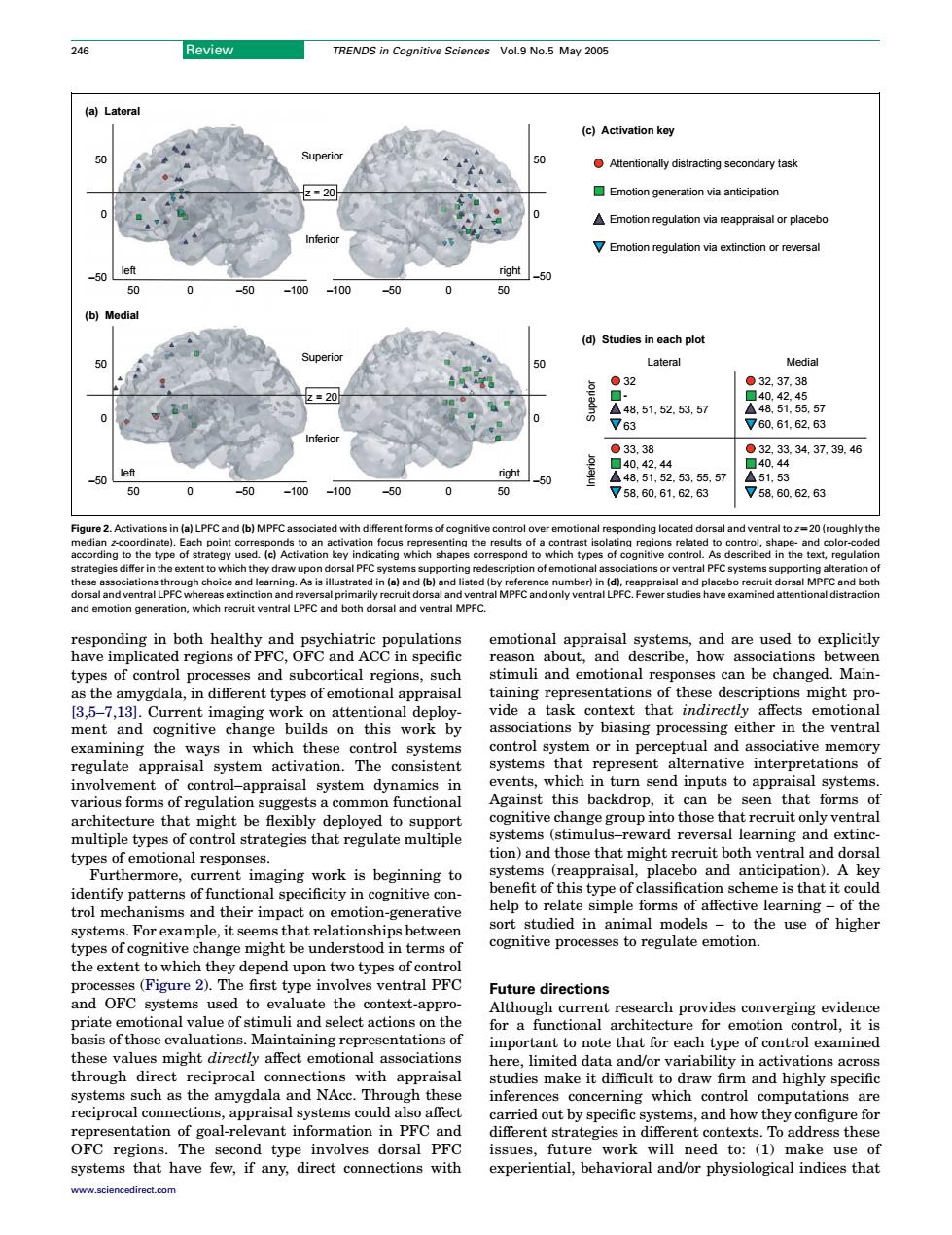正在加载图片...

Review TRENDS in Cognitive Sciences Vol.9 No.5 May 2005 (c)Act ation key Superior Emoin regulation via reappraisal or placebo -100 -100 -50 (b)Media 间s udies inc plot Later 8,51,52.53,57 9323834,37,3.46 100 100 -50 76066 75880.62.63 d. (al an FC and ventral LPEC an land ve I MPFC emotional appraisal systems,and are used to explicitly sp e about nbe ch s the dala in different t taining repr ntations of these descriptions might pr [3,5-7,13 Current imaging w ork on attentional deploy vide a task context that indirectly an gnitive egulate appraisal system activation systems that represent alternative interpretations of involvement of contro-appraisa ents s a co. cognitive ch ange group into those that recruit only ventral multiple types of control strategies that regulate multiple reve ems praisal.placebo and anticipation).A ke enit of this type of as ative ion scheme is thatitc trol mechanisms and their impact on otion-ger ort studied in animal models to the use of higher systemsFor ample, s betweer cognitive processes to regulate emotion. pes ant towhich th processes(Figure 2).The frst type PFC Future direction nd OFC syst ems used to evaluate the Although current research provides converging for a functiona ehremotioncontrol,iti po limited data reciproc udies make it difficult to draw firm and highly specific TA could also affect ng cont comput at by The involves dorsal to ystems and heed or physresponding in both healthy and psychiatric populations have implicated regions of PFC, OFC and ACC in specific types of control processes and subcortical regions, such as the amygdala, in different types of emotional appraisal [3,5–7,13]. Current imaging work on attentional deployment and cognitive change builds on this work by examining the ways in which these control systems regulate appraisal system activation. The consistent involvement of control–appraisal system dynamics in various forms of regulation suggests a common functional architecture that might be flexibly deployed to support multiple types of control strategies that regulate multiple types of emotional responses. Furthermore, current imaging work is beginning to identify patterns of functional specificity in cognitive control mechanisms and their impact on emotion-generative systems. For example, it seems that relationships between types of cognitive change might be understood in terms of the extent to which they depend upon two types of control processes (Figure 2). The first type involves ventral PFC and OFC systems used to evaluate the context-appropriate emotional value of stimuli and select actions on the basis of those evaluations. Maintaining representations of these values might directly affect emotional associations through direct reciprocal connections with appraisal systems such as the amygdala and NAcc. Through these reciprocal connections, appraisal systems could also affect representation of goal-relevant information in PFC and OFC regions. The second type involves dorsal PFC systems that have few, if any, direct connections with emotional appraisal systems, and are used to explicitly reason about, and describe, how associations between stimuli and emotional responses can be changed. Maintaining representations of these descriptions might provide a task context that indirectly affects emotional associations by biasing processing either in the ventral control system or in perceptual and associative memory systems that represent alternative interpretations of events, which in turn send inputs to appraisal systems. Against this backdrop, it can be seen that forms of cognitive change group into those that recruit only ventral systems (stimulus–reward reversal learning and extinction) and those that might recruit both ventral and dorsal systems (reappraisal, placebo and anticipation). A key benefit of this type of classification scheme is that it could help to relate simple forms of affective learning – of the sort studied in animal models – to the use of higher cognitive processes to regulate emotion. Future directions Although current research provides converging evidence for a functional architecture for emotion control, it is important to note that for each type of control examined here, limited data and/or variability in activations across studies make it difficult to draw firm and highly specific inferences concerning which control computations are carried out by specific systems, and how they configure for different strategies in different contexts. To address these issues, future work will need to: (1) make use of experiential, behavioral and/or physiological indices that right z = 20 Inferior Superior left (b) Medial –100 –50 0 50 0 right z = 20 left Inferior Superior 50 0 –50 50 0 (a) Lateral (c) Activation key 32 - 48, 51, 52, 53, 57 63 33, 38 40, 42, 44 48, 51, 52, 53, 55, 57 58, 60, 61, 62, 63 32, 37, 38 40, 42, 45 48, 51, 55, 57 60, 61, 62, 63 32, 33, 34, 37, 39, 46 40, 44 51, 53 58, 60, 62, 63 Lateral Medial Superior Inferior (d) Studies in each plot –50 50 0 –50 –100 –50 50 0 –50 50 50 –100 50 0 –50 –100 –50 0 Attentionally distracting secondary task Emotion regulation via reappraisal or placebo Emotion regulation via extinction or reversal Emotion generation via anticipation Figure 2. Activations in (a) LPFC and (b) MPFC associated with different forms of cognitive control over emotional responding located dorsal and ventral to zZ20 (roughly the median z-coordinate). Each point corresponds to an activation focus representing the results of a contrast isolating regions related to control, shape- and color-coded according to the type of strategy used. (c) Activation key indicating which shapes correspond to which types of cognitive control. As described in the text, regulation strategies differ in the extent to which they draw upon dorsal PFC systems supporting redescription of emotional associations or ventral PFC systems supporting alteration of these associations through choice and learning. As is illustrated in (a) and (b) and listed (by reference number) in (d), reappraisal and placebo recruit dorsal MPFC and both dorsal and ventral LPFC whereas extinction and reversal primarily recruit dorsal and ventral MPFC and only ventral LPFC. Fewer studies have examined attentional distraction and emotion generation, which recruit ventral LPFC and both dorsal and ventral MPFC. 246 Review TRENDS in Cognitive Sciences Vol.9 No.5 May 2005 www.sciencedirect.com